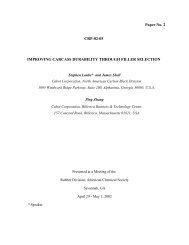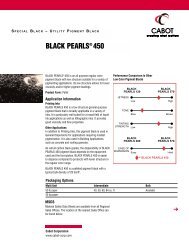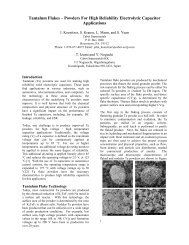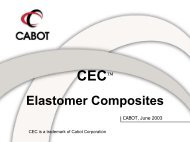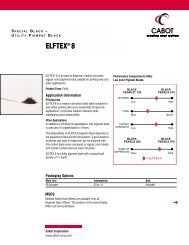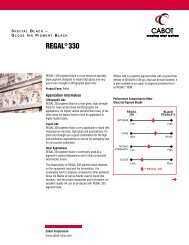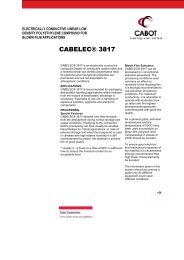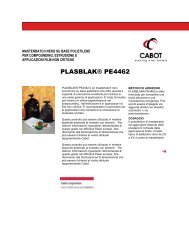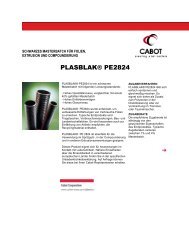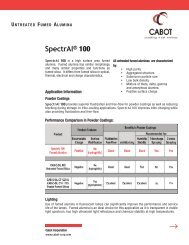Electrical Resistivity - Cabot Corporation
Electrical Resistivity - Cabot Corporation
Electrical Resistivity - Cabot Corporation
Create successful ePaper yourself
Turn your PDF publications into a flip-book with our unique Google optimized e-Paper software.
<strong>Electrical</strong> <strong>Resistivity</strong> in EPDM RubberCompoundsSPHERON ® 6400, 6000 and 5000 carbon blacks vs.STERLING ® SO - ASTM N550 in a 60-65 Shore EPDM testformulationCABOT , January 2004SPHERON® and STERLING® are registered trademarks of <strong>Cabot</strong> <strong>Corporation</strong>
<strong>Electrical</strong> <strong>Resistivity</strong>Part of the automotive industry is currentlyspecifying the specific electrical resistivity forrubber and other polymeric parts in contactwith Aluminium, Magnesium :• Aluminum≥ 10 6 Ω.cm• Magnesium≥ 10 9 Ω.cmPage 2
Influence of carbon black properties• Main factors of Carbon Black whichinfluence electrical conductivity /resistivity :– Aggregate morphology/size– Carbon black dosageincreasingimportance– Cristallinity (or graphitisation)Page 5
<strong>Electrical</strong> <strong>Resistivity</strong><strong>Electrical</strong> resistivityis influenced by :A B C D• Carbon black type• Carbon black dosage<strong>Electrical</strong> resistivity Ω.cmCarbon black concentrationPage 6
<strong>Electrical</strong> <strong>Resistivity</strong>Influence of carbon black concentration and critical volume fraction f c<strong>Electrical</strong> resistivityInsulatingZonePercolationZoneConductiveZonePage 7Carbon black concentrationincreasing
<strong>Electrical</strong> Conductivity• All carbon blacks show a similar pattern ofbehavior - they only differ in the critical volumeconcentrations required for the point whenelectrical resistivity starts to decrease /conductivity increases• The critical concentration or critical volumefraction f c of the carbon black influences theevolution in the Percolation Zone and theconductivity level in the Conductive ZonePage 8
Percolation for a Conductive Path(Condition for electrical conductivity)• The start of Percolation is the point whenelectron tunneling begins and aconductive path develops through thecompoundPage 9
<strong>Electrical</strong> Conductive Path• For the beginning of electricalconductivity through a compound, thecritical volume fraction f c of the carbonblack has to be exceeded• Critical Volume Fraktion f c depends onthe morphology of the carbon black :• Structure (Crushed OAN)• as well as Surface Area (STSA) andPorosity of the Carbon BlackPage 10
Influence of the Carbon Black• Larger aggregates increase the possibility ofcontact to other carbon black particles• To cause compound conductivity, carbon blackparticles must have contact points - so that higherstructured carbon blacks give higher electricalconductivity• <strong>Electrical</strong> resistivity is a function of the averagedistance between carbon black aggregates(dependent on particle size, surface area, andaggregate morphology).Page 11
Carbon Black Morphology• Low Structure/Surface Area– Aggregates are smaller– Less possibilities for contacts– Pack density (concentration)must be higher in order tocreate conductivity• High Structure / SurfaceArea– Aggregates are larger– More possibilities for contacts– Pack density can be lowerbefore conductivity developsPage 12
Carbon Black Analyticals:Carbon black typeSTSA Iodine Tint OAN C-OANSTERLING ® SO - ASTM N550 40 43 60 120 82SPHERON ® 5000 carbon black 28 27 45 120 80SPHERON ® 6000 carbon black21 20 37 92 70SPHERON ® 6400 carbon black18 16 34 95 71Page 13
Loading Capability of Carbon Blacks• SPHERON ® 6400 carbonblack• SPHERON ® 6000 carbonblack• SPHERON ® 5000 carbonblack• ASTM N550Loadability higherEl. resistivity higherEl. conductivity higherPage 14
Carbon Black Properties for High <strong>Electrical</strong> <strong>Resistivity</strong>• Carbon blacks with low STSA can be used at higher loadingsbefore electrical conductivity starts• Carbon blacks with low crushed OAN can be used at higherloadings before electrical conductivity starts– ASTM N550 higher electrical conductivity– SPHERON ® 5000 carbon black– SPHERON ® 6000 carbon black– SPHERON ® 6400 carbon black higher electrical resistivityPage 15
Dependency of Mixing Time / Dispersionon<strong>Electrical</strong> ConductivityConductivityOptimumMixing timePage 16
Formulations 60-65 Shore A compound seriesEPDM 100 100 100 100 100 100 100 100 100 100 100 100 100(55% ethylene, 11% diene)Calcium Carbonate 15 15 15 15 15 15 15 15 15 15 15 15 15Paraffinic Oil 65 65 65 65 65 65 65 65 65 65 65 65 65Zinc Oxide 7 7 7 7 7 7 7 7 7 7 7 7 7Stearic Acid 1 1 1 1 1 1 1 1 1 1 1 1 1Calcium Oxide 5 5 5 5 5 5 5 5 5 5 5 5 5Sulphur 1 1 1 1 1 1 1 1 1 1 1 1 1PEG 4000 3 3 3 3 3 3 3 3 3 3 3 3 3Natural silica 100 75 55 100 75 55 100 75 55 100 75 55 40(quartz/kaolinite)ASTM N550 60 68 75 --- --- --- --- --- --- --- --- --- ---SPHERON® 5000 --- --- --- 65 73 80 --- --- --- --- --- --- ---SPHERON® 6000 --- --- --- --- --- --- 75 87 95 --- --- --- ---SPHERON® 6400 --- --- --- --- --- --- --- --- --- 78 89 98 109MBT, 75% 1,5 1,5 1,5 1,5 1,5 1,5 1,5 1,5 1,5 1,5 1,5 1,5 1,5TMTD, 75% 0,8 0,8 0,8 0,8 0,8 0,8 0,8 0,8 0,8 0,8 0,8 0,8 0,8DPTTS, 75% 0,8 0,8 0,8 0,8 0,8 0,8 0,8 0,8 0,8 0,8 0,8 0,8 0,8ZDBC, 75% 0,8 0,8 0,8 0,8 0,8 0,8 0,8 0,8 0,8 0,8 0,8 0,8 0,8ZDEC, 75% 0,8 0,8 0,8 0,8 0,8 0,8 0,8 0,8 0,8 0,8 0,8 0,8 0,8Page 17
ResultsCarbon Black ASTM N550 SPHERON® 5000 SPHERON® 6000 SPHERON® 6400Loading, (phr) 60 68 75 65 73 80 75 87 95 78 89 98 109quarts/kaolinite, (phr) 100 75 55 100 75 55 100 75 55 100 75 55 40Carbon Black, wt% 16,5 19,7 22,6 17,7 20,9 23,8 19,9 23,9 27 20,5 24,3 27,6 31,1--- MDR @170°C ---Min.Torque, (dNm) 1,7 1,7 1,8 1,9 2,1 1,8 1,9 1,8 2,2 1,9 1,8 1,8 1,7Max.Torque, (dNm) 24,7 24,1 23,6 28,8 25,4 22,7 27,4 24,9 20,1 29,5 24 24 22,9Scorch 3, (m.m.) 0,6 0,6 0,6 0,7 0,7 0,6 0,6 0,6 0,7 0,7 0,6 0,6 0,6T50, (m.m.) 1 1 0,9 1,1 1 0,9 1 0,9 1 1,1 0,9 0,9 0,9T90, (m.m.) 2,6 3,3 3,1 2,3 3,6 3,5 2,4 3,1 3,7 2,4 3,2 3,6 2,7--- Mooney Viscosity ---ML (1+4) @ 100°C, (M.U.) 49 48 48 51 49 50 52 52 52 53 52 51 53--- Hardness ---Shore A, (3 sec.) 62 62 62 63 63 63 64 63 63 64 63 63 64--- Compression Set ---Set 22hrs @100°C, (%) 55 49 47 59 48 45 59 49 47 60 48 47 44--- Volume <strong>Resistivity</strong> ---log Rho (DIN 53482) 12,7 8,7 6,5 14,6 12,4 8,1 14 9,1 7,6 14,3 13 9,8 7,9--- Tensile ---Tensile Strength, (MPa) 9,5 9,7 10,9 10,1 10,1 10 8,9 8,9 9,1 8,5 8,6 8,5 9,9Elongation @ Break, (%) 438 401 426 493 413 369 470 417 354 479 430 387 40850% Modulus, (MPa) 1,4 1,4 1,5 1,5 1,5 1,5 1,6 1,5 1,5 1,6 1,6 1,6 1,7100% Modulus, (MPa) 2,3 2,4 2,6 2,5 2,5 2,8 2,6 2,5 2,9 2,5 2,6 2,8 3300% Modulus, (MPa) 5,7 6,4 7 5,6 6,5 7,4 5,4 6,1 7,5 5,1 5,7 6,3 6,7Page 18
Carbon Black wt% vs. Volume resistivityVolume <strong>Resistivity</strong> vs. Carbon Black Grade and LoadingLog R, (ohm.cm)161412108ASTM N550SPHERON® 5000SPHERON® 6000SPHERON® 6400615 18 21 24 27 30Carbon Black, (wt%)Page 19
Problems associated with the use ofhigh levels of white fillers:• Mixing• Incorporation• Dispersion• Extrusion (quality and speed)• Die plating• Poor dielectric properties (UHF)• Rubber compound/final article propertiesPage 20
Carbon Black Filled Compounds forHigher <strong>Electrical</strong> <strong>Resistivity</strong>• High carbon black loading for :– processing properties– physical properties• Correct choice of carbon black type for :– higher electrical resistivity– at higher loadings for processing and physicalproperties===> SPHERON 6400 offers a improved balancein that vs. standard grade like e.g. ASTM N550 !"#$%#&$%%'((#)$)*+()$$!(#&+%#)"#%,"#-&)(. #%#/!(0#)$$0!(+(#,%(+,(+!$)$!12$,.#0!(&#!12/+(!",!(12#)%%),%+(!+)(/#0(#-)&)# Page 21



